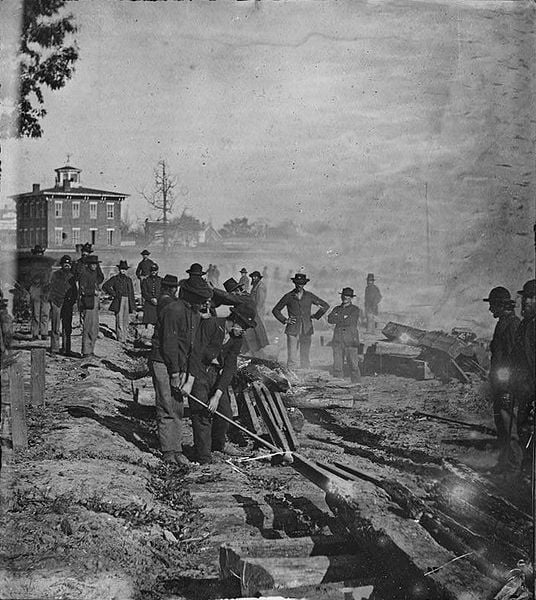*Image Credit: Wikimedia Commons In a bid to unhinge the Confederate States of America’s ability to make war against the Union Army, General William Tecumseh Sherman launched an aggressive strategy against the South by turning his soldiers toward Savannah, Georgia on November 15, 1864. Beginning his “March to the Sea” in the smoldering city of Atlanta, he hoped to move east to the Atlantic, then turn north to sandwich the army of Robert E. Lee between his own and that of his commander, Ulysses S. Grant, to end the rebellion. His tactics, however, would leave many wondering about the costs of victory. A graduate of the United States Military Academy, Sherman saw first action as a young lieutenant during the Second Seminole War in 1840. A popular figure amongst both the soldiers and throughout society, he moved into the private sector as the manager of a bank in San Francisco in 1853 after leaving military service. Bouncing around the country as the institution folded under financial pressure in 1857, Sherman landed at the Louisiana State Seminary of Learning and Military Academy. When the United States began dissolving early in 1861, Sherman felt deeply that the wrong decision had been made by his friends in the South. Resigning his position instead of supporting the rebellion, he managed to secure a commission in the army through his brother John, a Senator representing their native Ohio. Receiving the rank of colonel, he led volunteers at the First Battle of Bull Run. Promoted after acquitting himself well in an otherwise forgettable outing for the Union, he was relieved of command late in 1861 due to the stresses of overseeing operations in Kentucky. Eventually moved under Grant’s leadership in the spring of 1862, Sherman flourished, helping to achieve successive victories at Shiloh, Vicksburg and then Chattanooga by early 1864. With Grant promoted to the head of the Union Army, Sherman moved once again into command, this time of all the divisions fighting in the Western Theater. Unlike three years before in Kentucky, he seized the opportunity with both hands. Capturing Atlanta in early September, Sherman gained some fame in the North, though his policy of burning the government buildings might have been unpopular if the scale of its devastation had been known. Convincing Grant his business lay to the south, Sherman left a portion of his army to combat Confederate soldiers moving into Tennessee in order to begin the Savannah Campaign on November 15, 1864. Cutting his supply lines with a plan to live off the land — in fact, choosing a route through Georgia based on where he felt his troops would have the best access to food — Sherman began his infamous “March to the Sea.” Moving nearly 200 miles in less than a month, Sherman’s army set everything of military value on fire as they passed. Railroads were rendered inoperable, fields were burned and government buildings demolished. The scorched earth policy made his superiors uneasy, but it was difficult to argue with its effectiveness when Sherman forced the surrender of Savannah on December 21st. “I beg to present you as a Christmas gift the City of Savannah,” he wrote to President Abraham Lincoln, who gladly accepted. His men would spend the remainder of the winter in town, resting from the long haul. In many ways, the March had broken the Southern spirit and fostered resentment. With an $100 million in damage, according to Sherman’s own estimate, it is easy to see why. As his army left Savannah to turn north with the spring thaw, he continually pushed the Confederate Army under General Joseph E. Johnston back towards Lee’s forces in Virginia. On April 26, 1865, two weeks after Grant accepted Lee’s surrender at Appomattox Courthouse, Sherman received a formal declaration of capitulation from Johnston. Though his strategy remains a point of contention among scholars even today, Sherman’s contribution to the Union victory through the March to the Sea cannot be argued. Also On This Day: 1859 – A modern Olympic Games takes place in Athens 35 years before the International Olympic Committee is established 1920 – The League of Nations meets for the first time in Geneva 1942 – The Allies claim victory in the Pacific Theater at the Battle of Guadalcanal 1971 – Intel releases the first single-chip microprocessor 2000 – Jharkhand gains statehood by separating from neighboring Bihar in eastern India
November 15 1864 CE – Union General William Tecumseh Sherman Begins His March to the Sea by Burning Atlanta
*Image Credit: Wikimedia Commons In a bid to unhinge the Confederate States of America’s ability to make war against the Union Army, General William Tecumseh Sherman launched an aggressive strategy…
261
